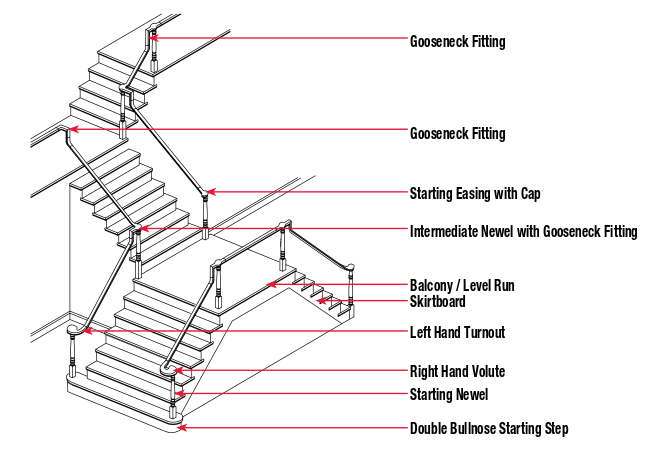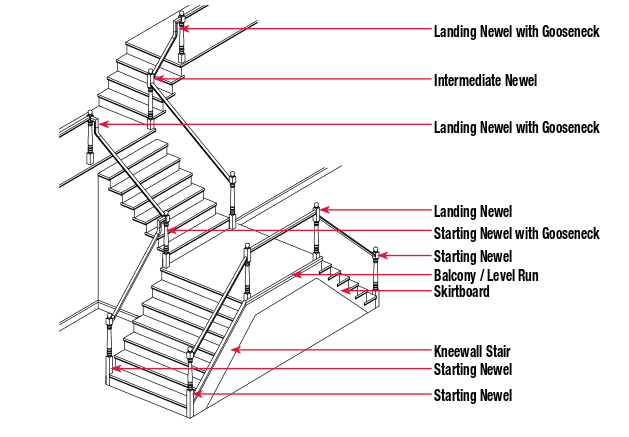Specification
- 8095 Cove Moulding
- 5/8″ x 13/16″


90 Degree Upeasing Upeasing that quickly transitions hand rail from level to vertical.
Baluster Decorative vertical member of a balustrade system. Balusters are usually 1-1/4″, 1-5/8″ or 1-3/4″ square.
Balustrade Hand rail system located on the open side of a stairway that consists of newel post, balusters, and rail components.
Box Newel Type of newel that is usually constructed like a box, often having a hollow center. Box newels are usually square rather than turned on a lathe.
Carriage A supporting member running the length of the stairway on which treads, risers, and balustrade are mounted (also referred to as rough stringers or rough horses).
Coped End Fitting Hand rail fitting with one end coped to match the profile of a fitting cap. When attached to the hand rail on one end and a cap on the other, the installer can build special angle fittings.
Cove Mould Decorative trim which is used to cover the joint between the tread/riser and the landing tread/landing face.
False Riser Economical alternative to a full riser. Riser cap is installed over a portion of the rough framed riser to simulate the look of a solid riser. Ideal for center carpeted stairways.
False Tread Economical alterative to a full tread. Tread cap is installed over a portion of the rough framed tread on the open side of a stairway to simulate the look of a solid tread. Ideal for center carpeted stairways.
Fillet Decorative wood strips used to fill the plow between balusters on plowed hand rail and plowed shoe rail.
Gooseneck Fitting consisting of one or two upeasings, one rail drop, and one or two level fitting components. Used to make transitions at landings.
Hand Rail Portion of the balustrade system which sits on top of the balusters and is supported by the newel posts.
Hand Rail Fittings Components that make transitions in hand rail height or pitch. Also allows the hand rail to run over the newel post. Components attach to the hand rail and are profiled to match the hand rail pattern.
Intermediate Landing Platform separating flights of stairs.
Intermediate Newel Post Newel post at the corner of an intermediate landing where two rake rails meet.
Kneewall Wall on the balustrade system side of the stair that extends just a few inches above the nose of the treads. The balustrade system attaches to the kneewall and adjacent framing members.
Landing Newel Newel post at the top of a flight of steps, located at the point where a rake hand rail and a level hand rail intersect.
Landing Tread Moulding used to give the appearance of a tread with nosing at the top riser of a flight of stairs and along the open edge of second floor balconies and intermediate landings.
Newel Post Major support post in balustrade system. Newel posts are located at the bottom and top of flights of stairs, as support posts in long balustrade lengths on second floor landings, and at direction changes.
Pin Top Balusters Balusters with a turned area that extend to the top of the baluster. They are connected to the hand rail by inserting the round top of the baluster into a hole drilled in the bottom of the hand rail.
Riser Vertical component of a step which your toe might hit when walking on a stairway.
Rosette Decorative piece used where the hand rail meets a wall.
Second Floor Landing Floor area at the top of a stairway. The second floor landing is commonly referred to as the balcony.
Shoe Mould Decorative moulding used to cover the joint between the bottom riser and the floor.
Shoe Rail Plowed bottom rail of a balustrade system, which houses the bottom block of a baluster.
Skirtboard Decorative trim board used in carriage built stairways to trim the area of the carriage on the open side of the stairway and as a moulding on the closed side of the stairway.
Square Top Balusters Balusters that are square on the top and bottom. Fits securely in a plowed hand rail.
Starting Easing Fitting used as a decorative beginning at the bottom of a wall rail.
Starting Fitting Decorative beginning to an over the post hand rail system.
Starting Newel Newel used at the bottom of a stairway.
Starting Step Bottom tread and riser of a stair. Starting steps often have rounded ends, called bullnoses, that extend beyond the carriage of the stairway. Bullnosed starting steps are necessary for over the post balustrades beginning with volutes or turnouts.
Tread The part of a step that is walked on.
Tread Bracket Decorative piece mitered to the riser and fastened on the side of an open skirtboard.